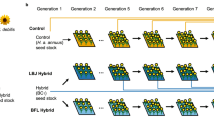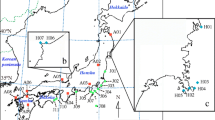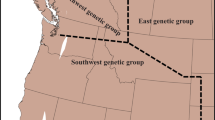Abstract
Although invasive plant species often have a hybrid ancestry, unambiguous evidence that hybridization has stimulated the evolution of invasive behaviors has been difficult to come by. Here, we briefly review how hybridization might contribute to the colonization of novel habitats, range expansions, and invasiveness and then describe work on hybrid sunflowers that forges a direct link between hybridization and ecological divergence. We first discuss the invasion of Texas by the common sunflower and show that the introgression of chromosomal segments from a locally adapted species may have facilitated range expansion. We then present evidence that the colonization of sand dune, desert floor, and salt marsh habitats by three hybrid sunflower species was made possible by selection on extreme or “transgressive” phenotypes generated by hybridization. This body of work corroborates earlier claims regarding the role of hybridization in adaptive evolution and provides an experimental and conceptual framework for ongoing studies in this area.





Similar content being viewed by others
References
Abbott R (1992) Plant invasions, interspecific hybridization and the evolution of new plant taxa. Trends Ecol Evol 7:401–405
Abbott RJ, James JK, Milne RI, Gillies ACM (2003) Plant introductions, hybridization and gene flow. Phil Trans R Soc B 358:1123–1132
Ainouche ML, Baumel A, Salmon A, Yannic G (2003) Hybridization, polyploidy and speciation in Spartina (Poaceae). New Phytol 161:165–172
Al-Khatib K, Baumgartner JR, Peterson DE, Currie RS (1998) Imazethapyr resistance in common sunflower (Helianthus annuus). Weed Sci 46:403–407
Anderson E (1948) Hybridization of the habitat. Evolution 2:1–9
Anderson E (1949) Introgressive hybridization. John Wiley and Sons, New York
Anderson E, Stebbins GL (1954) Hybridization as an evolutionary stimulus. Evolution 8:378–388
Antonovics J (1976) The nature of limits to natural selection. Ann MO Bot Gard 63:224–247
Arnold ML (1997) Natural hybridization and evolution. Oxford Univ. Press, Oxford
Arnold ML (2004) Transfer and origin of adaptations through natural hybridization: were Anderson and Stebbins right? Plant Cell 16:562–570
Arnold ML, Hodges SA (1995) Are natural hybrids fit or unfit relative to their parents? Trends Ecol Evol 10:67–71
Avise JC (1994) Molecular markers, natural history, and evolution. Chapman & Hall, New York
Baker HG (1972) Migration of weeds. In: Valentine DH (ed) Taxonomy, phytogeography and evolution. Academic Press, London, pp 327–347
Baker HG, Stebbins GL (1965) The genetics of colonizing species. Academic Press, New York
Barrett SCH (1983) Crop mimicry in weeds. Econ Bot 37:255–282
Barton NH (2001) The role of hybridisation in evolution. Mol Ecol 10:551–568
Barton NH, Hewitt GM (1985) Analysis of hybrid zones. Ann Rev Ecol Syst 16:113–148
Blumler MA (2003) Introgression as a spatial phenomenon. Phys Geogr 24:414–432
Buerkle CA, Morris RJ, Asmussen MA, Rieseberg LH (2000) The likelihood of homoploid hybrid speciation. Heredity 84:441–451
Buerkle CA, Wolf DE, Rieseberg LH (2003) The origin and extinction of species through hybridization. In: Brigham CA, Schwartz MW (eds) Population viability in plants. Springer Verlag, Berlin, pp 117–141
Burke JM, Bulger MR, Wesselingh RA, Arnold ML (2000) Frequency and spatial patterning of clonal reproduction in Louisiana iris hybrid populations. Evolution 54:137–144
Burke JM, Lai Z, Salmaso M, Nakazato T, Tang S, Heesacker A, Knapp SJ, Rieseberg LH (2004) Comparative mapping and rapid karyotypic evolution in the genus Helianthus. Genetics 167:449–457
Chandler JM, Jan C, Beard BH (1986) Chromosomal differentiation among the annual Helianthus species. Syst Bot 11:353–371
Charlesworth D (1995) Evolution under the microscope. Curr Biol 5:835–836
Clausen J, Hiesey WM (1958) Experimental studies on the nature of species. IV. Genetic structure of ecological races. Carnegie Institute of Washington, Washington, DC
deVicente MC, Tanksley SD (1993) QTL analysis of transgressive segregation in an interspecific tomato cross. Genetics 134:585–596
Dorado O, Rieseberg LH, Arias D (1992) Chloroplast DNA introgression in southern California sunflowers. Evolution 46:566–572
Doebley J, Stec A, Gustus C (1995) Teosinte Branched1 and the origin of maize – evidence for epistasis and the evolution of dominance. Genetics 141:333–346
Ellstrand NC (2003) Dangerous liaisons? When cultivated plants mate with their wild relatives. John Hopkins University Press, Balitmore, MD
Ellstrand NC, Schierenbeck KA (2000) Hybridization as a stimulus for the evolution of invasiveness in plants? Proc Natl Acad Sci 97:7043–7050
Ellstrand NC, Whitkus R, Rieseberg LH (1996) Distribution of spontaneous plant hybrids. Proc Natl Acad Sci USA 93:5090–5093
Erlich PR (1989) Attributes of invaders and the invading process: vertebrates. In: Drake JA, Mooney HA, di Castri F, Groves RH, Kruger FJ, Rejmanek M, Williamson M (eds) Biological invasions: a global perspective. John Wiley, London, pp 315–328
Fritz RS, Moulia C, Newcombe G (1999) Resistance of hybrid plants and animals to herbivores, pathogens, and parasites. Annu Rev Ecol Syst 30:565–591
Fry JD (2003) Detecting ecological trade-offs using selection experiments. Ecology 84:1672–1678
Galatowitsch SM, Anderson NO, Ascher PD (1999) Invasiveness in wetland plants in temperate North America. Wetlands 19:733–755
Gaskin JF, Schaal BA (2002) Hybrid Tamarix widespread in US invasion and undetected in native Asian range. Proc Natl Acad Sci USA 99:11256–11259
Gottlieb LD (1972) Levels of confidence in the analysis of hybridization in plants. Ann MO Bot Gard 59:435–446
Grant V (1981) Plant speciation. Columbia Univ. Press, New York
Grant PR, Grant BR (1992) Hybridization of bird species. Science 256:193–197
Grant PR, Grant BR (2002) Unpredictable evolution in a 30-year study of Darwin’s finches. Science 296:707–711
Gray AJ, Marshall DF, Raybould AF (1991) A century of evolution in Spartina anglica. Adv Ecol Res 21:1–62
Grime JP (1977) Evidence for the existence of three primary strategies in plants and its relevance to ecological and evolutionary theory. Am Nat 111:1169–1194
Gross BL, Rieseberg LH (2005) The ecological genetics of homoploid hybrid speciation. J Hered 96:241–252
Gross BL, Schwarzbach AE, Rieseberg LH (2003) Origin(s) of the diploid hybrid species Helianthus deserticola (Asteraceae). Am J Bot 90:1708–1719
Gross BL, Kane NC, Lexer C, Ludwig F, Rosenthal DM, Donovan LA, Rieseberg LH (2004) Reconstructing the origin(s) of Helianthus deserticola: survivorship and selection on the desert floor. Am Nat 164:145–156
Grotkopp E, Rejmanek M, Rost TL (2002) Toward a causal explanation of plant invasiveness: seedling growth and life-history strategies of 29 pine (Pinus) species. Am Nat 159:396–419
Harlan JR, De Wet JMJ (1963) The compilospecies concept. Evolution 17:497–501
Harper JL (1977) Population biology of plants. Academic Press, New York
Hauser L, Carvalho GR, Pitcher TJ, Ogutu-Ohwayo R (1998) Genetic affinities of an introduced predator: Nile perch in Lake Victoria, East Africa. Mol Ecol 7:849–857
Heiser CB (1947) Hybridization between the sunflower species Helianthus annuus and H. petiolaris. Evolution 1:249–262
Heiser CB (1949) Study in the evolution of the sunflower species Helianthus annuus and H. bolanderi. Univ Calif Publ Bot 23:157–196
Heiser CB (1951a) Hybridization in the annual sunflowers: Helianthus annuus × H. argophyllus. Am Nat 85:64–72
Heiser CB (1951b) Hybridization in the annual sunflowers: Helianthus annuus × H. debilis var. cucumerifolius. Evolution 5:42–51
Heiser CB (1954) Variation and subspeciation in the common sunflower, Helianthus annuus. Am Midl Nat 51:287–305
Heiser CB (1965) Sunflowers, weeds, and cultivated plants. In: Barker HG, Stebbins GL (eds) The genetics of colonizing species. Academic Press, Orlando, FL, pp 391–401
Heiser CB, Smith DM, Clevenger S, Martin WC (1969) The North American sunflowers (Helianthus). Mem Torrey Bot Club 22:1–218
Hoffmann AA, Blows MW (1994) Species borders: ecological and evolutionary perspectives. Trends Ecol Evol 9:223–227
Hubbs CL (1955) Hybridization between fish species in nature. Syst Zool 4:1–20
Johnston JA, Grise DJ, Donovan LA, Arnold ML (2001) Environment-dependent performance and fitness of Iris brevicaulis, I. fulva (Iridaceae), and hybrids. Am J Bot 88:933–938
Kim S-C, Rieseberg LH (1999) Genetic architecture of species differences in annual sunflowers: implications for adaptive trait introgression. Genetics 153:965–977
Kim S-C, Rieseberg LH (2001) The contribution of epistasis to species differences in annual sunflowers. Mol Ecol 10:683–690
Kirkpatrick M, Barton NH (1997) Evolution of a species’ range. Am Nat 150:1–23
Lai Z, Nakazato T, Salmaso M, Burke JM, Tang S, Knapp SJ, Rieseberg LH (2005) Extensive chromosomal repatterning and the evolution of sterility barriers in hybrid sunflower species. Genetics 171:1933:1940
Lande R, Arnold SJ (1983) The measurement of selection on correlated characters. Evolution 37:1210–1226
Langevin SA, Clay K, Grace JB (1990) The incidence and effects of hybridization between cultivated rice and its related weed red rice (Oryza sativa L.). Evolution 44:1000–1008
Lee CE (2002) Evolutionary genetics of invasive species. Trends Ecol Evol 17:386–391
Levine JM, D’Antonio CM (1999) Elton revisited: a review of evidence linking diversity and invasibility. Oikos 87:15–26
Lewontin RC, Birch LC (1966) Hybridization as a source of variation for adaptation to new environments. Evolution 20:315–336
Levin DA, Clay K (1984) Dynamics of synthetic Phlox drummondii populations at the species margin. Am J Bot 71:1040–1050
Lexer C, Welch M, Durphy JL, Rieseberg LH (2003a) Natural selection for salt tolerance QTL in wild sunflower hybrids: implications for the origin of Helianthus paradoxus, a homoploid hybrid species. Mol Ecol 12:1225–1235
Lexer C, Welch M, Raymond O, Rieseberg LH (2003b) The origins of ecological divergence in Helianthus paradoxus (Asteraceae): selection on transgressive characters in a novel hybrid habitat. Evolution 57:1989–2000
Lexer C, Rosenthal DM, Raymond O, Donovan L, Rieseberg LH (2005) Genetics of species differences in the wild annual sunflowers, Helianthus annuus and H. petiolaris. Genetics 169:2225–2239
Lexer C, Lai Z, Rieseberg LH (2004) Candidate gene polymorphisms associated with salt tolerance in wild sunflower hybrids: implications for the origin of Helianthus paradoxus, a diploid hybrid species. New Phytol 161:225–233
Ludwig F, Rosenthal D, Johnston JA, Kane N, Gross BL, Lexer C, Dudley SA, Rieseberg LH, Donovan LA (2004) Selection on leaf ecophysiological traits in a hybrid Helianthus species and early generation hybrids in a desert dune habitat. Evolution 58:2682–2692
Lynch M, Walsh B (1998) Genetics and the analysis of quantitative traits. Sinauer Associates, Sunderland, MA
Mallet J (2005) Hybridization as an invasion of the genome. Trends Ecol Evol 20:229–237
Marshall JK (1968) Factors limiting the survival of Corynephorus canescens (L.) Beauv. in Great Britain at the northern edge of its distribution. Oikos 19:206–216
Milne RI, Abbott RJ (2000) Origin and evolution of invasive naturalized material of Rhododendron ponticum L. in the British Isles. Mol Ecol 9:541–556
Moody ML, Les DH (2002) Evidence of hybridity in invasive watermilfoil (Myriophyllum) populations. Proc Natl Acad Sci USA 99:14867–14871
Neuffer B, Auge H, Mesch H, Amarell U, Brandl R (1999) Spread of violets in polluted pine forests: morphological and molecular evidence for the ecological importance of interspecific hybridization. Mol Ecol 8:365–377
Ochman H, Lawrence JG, Groisman EA (2000) Lateral gene transfer and the nature of bacterial innovation. Nature 405:299–304
Orians CM (2000) The effects of hybridization in plants on secondary chemistry: implications for the ecology and evolution of plant–herbivore interactions. Am J Bot 87:1749–1756
Otto SP, Whitton J (2000) Polyploid incidence and evolution. Annu Rev Genet 34:401–437
Pianka ER (1970) On r and K selection. Am Nat 102:592–597
Pimental D, Lach L, Zuniga R, Morrison D (2000) Environmental and economic costs of nonindigenous species in the United States. BioScience 50:53–65
Pires JC, Zhao JW, Schranz ME, Leon EJ, Quijada PA, Lukens LN, Osborn TC (2004) Flowering time divergence and genomic rearrangements in resynthesized Brassica polyploids (Brassicaceae). Biol J Linn Soc 82:675–688
Prince SD, Carter RN, Dancy KJ (1985) The geographical distribution of prickly lettuce (Lactuca serriola) II. Characteristics of populations near its distribution limit in Britain. J Ecol 73:39–48
Rattenbury JA (1962) Cyclic hybridization as a survival mechanism in the New Zealand forest flora. Evolution 16:348–363
Raven PH (1976) The bases of angiosperm phylogeny: cytology. Ann MO Bot Gard 62:409–451
Rejmanek M, Richardson DM (1996) What attributes make some plant species more invasive? Ecology 77:1655–1660
Rieseberg LH (1991) Homoploid reticulate evolution in Helianthus: evidence from ribosomal genes. Am J Bot 78:1218–1237
Rieseberg LH (2000) Crossing relationships among ancient and experimental sunflower hybrid lineages. Evolution 54:859–865
Rieseberg LH, Soltis DE (1991) Phylogenetic consequences of cytoplasmic gene flow in plants. Evol Trends Plants 5:65–84
Rieseberg LH, Wendel J (1993) Introgression and its consequences in plants. In: Harrison R (ed) Hybrid zones and the evolutionary process. Oxford University Press, New York, pp 70–114
Rieseberg LH, Soltis DE, Palmer JD (1988) A molecular reexamination of introgression between Helianthus annuus and H. bolanderi. Evolution 42:227–238
Rieseberg LH, Beckstrom-Sternberg S, Doan K (1990a) Helianthus annuus ssp. texanus has chloroplast DNA and nuclear ribosomal RNA genes of Helianthus debilis ssp. cucumerifolius. Proc Natl Acad Sci USA 87:593–597
Rieseberg LH, Carter R, Zona S (1990b) Molecular tests of the hypothesized hybrid origin of two diploid Helianthus species (Asteraceae). Evolution 44:1498–1511
Rieseberg LH, Beckstrom-Sternberg S, Liston A, Arias D (1991a) Phylogenetic and systematic inferences from chloroplast DNA and isozyme variation in Helianthus sect. Helianthus. Syst Bot 16:50–76
Rieseberg LH, Choi H, Ham D (1991b) Differential cytoplasmic versus nuclear gene flow in Helianthus. J Hered 82:489–493
Rieseberg LH, Desrochers A, Youn SJ (1995a) Interspecific pollen competition as a reproductive barrier between sympatric species of Helianthus (Asteraceae). Am J Bot 82:515–519
Rieseberg LH, Van Fossen C, Desrochers A (1995b) Hybrid speciation accompanied by genomic reorganization in wild sunflowers. Nature 375:313–316
Rieseberg LH, Sinervo B, Linder CR, Ungerer M, Arias DM (1996) Role of gene interactions in hybrid speciation: evidence from ancient and experimental hybrids. Science 272:741–745
Rieseberg LH, Archer MA, Wayne RK (1999a) Transgressive segregation, adaptation, and speciation. Heredity 83:363–372
Rieseberg LH, Whitton J, Gardner K (1999b) Hybrid zones and the genetic architecture of a barrier to gene flow between two wild sunflower species. Genetics 152:713–727
Rieseberg LH, Raymond O, Rosenthal DM, Lai Z, Livingstone K, Nakazato T, Durphy JL, Schwarzbach AE, Donovan LA, Lexer C (2003) Major ecological transitions in annual sunflowers facilitated by hybridization. Science 301:1211–1216
Rogers CE, Thompson TE, Seiler GJ (1982) Sunflower species of the United States. National Sunflower Association, Bismarck, ND
Rosenthal DM, Rieseberg LH, Donovan LA (2005) Recreating ancient hybrid species’ complex multi-trait phenotypes from early generation synthetic hybrids: three examples using wild sunflowers. Am Nat 166:26–41
Sakai AK, Allendorf FW, Holt JS, Lodge DM, Molofsky J, With KA, Baughmann S, Cabin RJ, Cohen JE, Ellstrand NC, McCauley DE, O’Neil P, Parker IM, Thompson JN, Weller SC (2001) The population biology of invasive species. Annu Rev Ecol Syst 32:305–332
Schemske DW (2000) Understanding the origin of species. Evolution 54:1069–1073
Schwarzbach AE, Rieseberg LH (2002) Likely multiple origins of a diploid hybrid sunflower species. Mol Ecol 11:1703–1717
Schwarzbach AE, Donovan LA, Rieseberg LH (2001) Transgressive character expression in a hybrid sunflower species. Am J Bot 88:270–277
Silander JA, Antonovics J (1979) The genetic basis of the ecological amplitude of Spartina patens. 1. Morphometric and physiological traits. Evolution 33:1114–1127
Small E (1984) Hybridization in the domesticated-weed-wild complex. In: Grant WF (ed) Plant biosystematics. Academic Press, Toronto, pp 195–210
Soltis DE, Soltis PS, Pires JC, Kovarik A, Tate JA, Mavrodiev E (2004) Recent and recurrent polyploidy in Tragopogon (Asteraceae): cytogenetic, genomic and genetic comparisons. Biol J Linn Soc 82:485–501
Sota T, Vogler AP (2001) Incongruence of mitochondrial and nuclear gene trees in Carabid beetles Ohomopterus. Syst Biol 50:39–59
Stace CA (1975) Hybridization and the Flora of the British Isles. Cambridge University Press, Cambridge
Stebbins GL (1957) The hybrid origin of microspecies in the Elymus glaucus complex. Cytolo Suppl 36:336–340
Stebbins GL (1959) The role of hybridization in evolution. Proc Am Phil Soc 103:231–251
Stebbins GL (1969) The significance of hybridization for plant taxonomy and evolution. Taxon 18:26–35
Stebbins GL (1985) Polyploidy, hybridization, and the invasion of new habitats. Ann MO Bot Gard 72:824–832
Strauss SY (1994) Levels of herbivory and parasitism in host hybrid zones. Trends Ecol Evol 9:209–214
Sun M, Corke H (1992) Population genetics of colonizing success of weedy rye in Northern California. Theor Appl Genet 83:321–329
Tanksley SD (1993) Mapping polygenes. Annu Rev Genet 27:205–233
Thompson JD (1991) The biology of an invasive plant – what makes Spartina anglica so successful? Bioscience 41:393–401
Wang H, McArthur ED, Sanderson SC, Graham JH, Freeman DC (1997) Narrow hybrid zone between two subspecies of big sagebrush (Artemisia tridentata): Asteraceae. IV: reciprocal transplant experiments. Evolution 51:95–102
Wang RL, Wakeley J, Hey J (1997) Gene flow and natural selection in the origin of Drosophila pseudoobscura and close relatives. Genetics 147:1091–1106
Weber E, D’Antonio CM (1999) Phenotypic plasticity in hybridizing Carpobrotus spp. (Aizoaceae) from coastal California and its role in plant invasion. Can J Bot/Rev Can Bot 77:1411–1418
Welch ME, Rieseberg LH (2002) Patterns of genetic variation suggest a single, ancient origin for the diploid hybrid species Helianthus paradoxus. Evolution 56:2126–2137
Wendel JF, Doyle JJ (1998) Phylogenetic incongruence: window into genome history and molecular evolution. In: Soltis DE, Soltis PS, Doyle JJ (eds) Molecular systematics of plants II: DNA sequencing. Kluwer Academic Publishers, Boston, pp 256–296
Wendel JF, Stewart JM, Rettig JH (1991) Molecular evidence for homoploid reticulate evolution among Australian species of Gossypium. Evolution 45:694–671
Wilkes HG (1977) Hybridization of maize and teosinte in Mexico and Guatemala and the improvement of maize. Econ Bot 31:254–293
Williamson M (1996) Biological invasions. Chapman & Hall, London
Acknowledgements
The research on sunflower hybridization described here has been supported by grants from the National Science Foundation, National Institutes of Health, and U.S. Department of Agriculture. This contribution was an invited paper for the 2004 Society for the Study of Evolution Symposium “All Stressed Out and Nowhere to Go: Does Evolvability Limit Adaptation in Invasive Species?”
Author information
Authors and Affiliations
Corresponding author
Rights and permissions
About this article
Cite this article
Rieseberg, L.H., Kim, SC., Randell, R.A. et al. Hybridization and the colonization of novel habitats by annual sunflowers. Genetica 129, 149–165 (2007). https://doi.org/10.1007/s10709-006-9011-y
Received:
Accepted:
Published:
Issue Date:
DOI: https://doi.org/10.1007/s10709-006-9011-y




